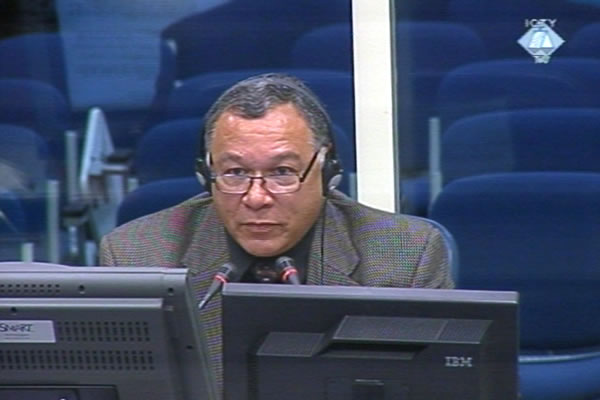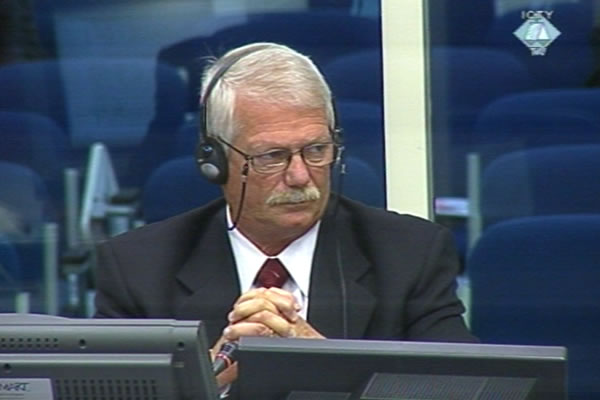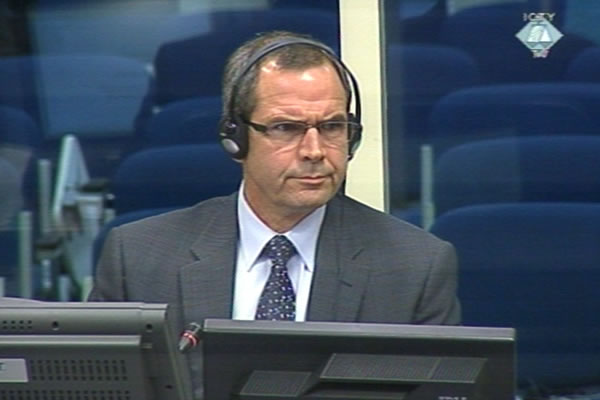Home
DENYING THE FIRST MARKALE SHELLING
Radovan Karadzic continued his defense case by calling three Canadian officers in a bid to contest the accusations related to the shelling of the Markale market on 5 February 1994. As alleged in the indictment, 66 persons were killed and over 140 wounded in explosion of a mortar shell
 Stephan Joudry, defence witness of Radovan Karadzic
Stephan Joudry, defence witness of Radovan Karadzic As Radovan Karadzic’s defense case continued, he called three Canadian officers in a bid to contest the allegations related to the Markale shelling on 5 February 1994. The indictment contends that 66 persons were killed and over 140 injured in the explosion of a 120-mm mortar shell fired from the Bosnian Serb positions north-northeast of the city.
Retired colonel Stephan Joudry was a senior staff officer in UNPROFOR in Zagreb at the time of the incident. Joudry analyzed the UN teams' reports and expressed 'serious reservations’ about the procedure and the way in which the incident was investigated. In Joudry's view, the crater analysis was not reliable enough to allow any conclusions as to who was to blame for the incident. On the other hand, Joudry believes that the Bosnian side threw the projectile from a nearby roof ‘by hand’.
In the cross-examination, prosecutor Alan Tieger insisted that the witness did not actually visit the scene, didn't see or investigate the crater, didn’t examine the stabilizer and the tail fin of the projectile or any other physical evidence and didn't speak with the witnesses of the incident. The Canadian colonel confirmed these claims. To show the absurdity of the claim that someone could throw in a shell weighing at least 12 kg, the prosecutor brought to the courtroom a dumbbell that weighed almost 12 kilos. Even if that were feasible, it was impossible to foresee the angle of impact of the shell, the prosecutor argued.
Karadzic then called John Russel to the witness stand. Russell served as aide de camp to Sergio de Mello. Russell was at the scene on the day of the Markale incident and participated in the investigation. As he arrived at the scene in the afternoon of 5 February 1994, the witness saw that the dead and the wounded had been removed and that shrapnel had been cleaned away. According to the witness's view, this 'interfered with the evidence'. According to him, the Bosnian police team could not have established accurately the angle of descent of the shell because the crater had been damaged in the meantime. Later that night, the witness noted in his diary that he thought the Bosnian side 'fired on its own people'.
As prosecutor Kimberly West argued in her cross-examination, the fact the shell fragments had been cleaned up couldn't have influenced the investigation because the caliber of the shell had been established based on other parts recovered at the scene of the incident. The witness claimed that the 'vertical' angle of descent indicated the shell had been fired from an area close to the scene. This prompted the prosecutor to say that the data the witness established at the scene compared to the firing tables indicated that the shell could have been fired from the distance of 900 to 4,800 m depending on the charge increment used.
Finally, Karadzic examined General Michel Gauthier. On 11 February 1994, Gauthier was sent from the UNPROFOR headquarters in Zagreb to Sarajevo as a leader of yet another team which was to investigate the Markale incident. Gauthier's team concluded that in the meantime the crater may have been 'dug up’ and ascertained that the estimated range from which the shell had been fired - between 300 to 5,500 m - covered the territory controlled by both sides in the conflict: either could have fired the round.
In the cross-examination, prosecutor Carolyn Edgerton noted that according to what UNPROFOR knew at the time, the Bosnian side didn't have mortar positions along the shell flight path. The witness also confirmed that the Serb side had one mortar position on that line, but his investigation team never sought permission to visit the area under Serb control because it would have been like 'looking for a needle in haystack', as the witness put it.
Photos
Linked Reports
- Case : Karadzic
- 2012-10-24 PAPOULIAS WILL NOT TESTIFY AT KARADZIC TRIAL
- 2012-10-23 DENYING SNIPER TERROR ATTACKS FROM SPICASTA STIJENA
- 2012-10-23 TARGETS OF MODIFIED AIR BOMBS
- 2012-10-31 CONTESTING THE RESULTS OF THE FIRST MARKALE MASSACRE INVESIGATION
- 2012-11-01 RESPONSIBILITY FOR MARKALE MASSACRE CONTESTED AGAIN
- 2012-11-05 MOMIR CLAIMS HE’S ‘MOCALO’ NOT ‘MOMO’


